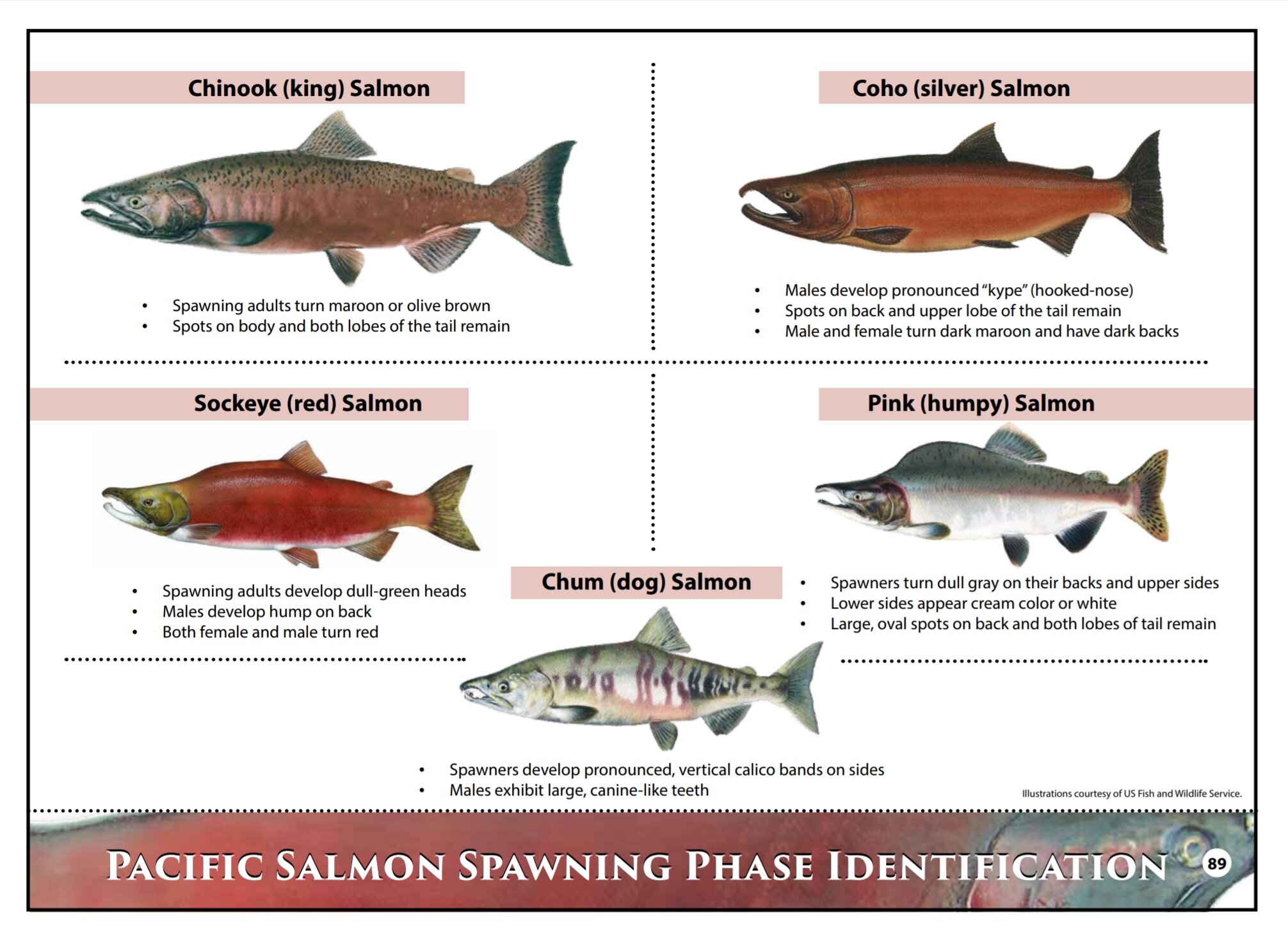Pink salmon, also known as humpies due to the distinctive humped back on spawning males, offer thrilling sport fishing opportunities across their native range extending from California up along the Pacific coast to Alaska and Russia. Anglers pursuing pink salmon need to know how to positively identify them in order to follow regulations, as they often share habitat with other salmon species This guide covers everything you need to know to successfully identify pink salmon.
Pink Salmon Physical Features
Pink salmon exhibit several distinctive physical features that set them apart from other salmon species
-
Spots – Very large black spots on the back and heavy oval shaped black blotches on the upper and lower lobes of the tail fin These blotchy spots help distinguish them from other spotted salmon like chinook and coho.
-
Mouth – The inside of the mouth is white with a solid black gumline and tongue. This contrasts with the completely black mouth of chinook salmon.
-
Scales – Very small, delicate scales compared to other salmon species. If you put a pink salmon next to a silver salmon, you can tell them apart.
-
Tail: The tail fin doesn’t have any silver color on it like silver and chinook salmon do. The tail remains dusky or dark-colored.
-
Size: They can grow up to 10 pounds, but most are 2 to 5 pounds, which is smaller than other salmon. Larger fish over 5 pounds are often mature females full of eggs.
Identification Tips by Life Stage
Identifying pink salmon becomes more challenging when they enter freshwater to spawn. Their ocean coloration fades as they make the transition to their spawning phase. Use these tips for identifying spawning pinks:
In Saltwater
-
Look for those very large spots and blotches on the back and tail fin lobes.
-
Check inside the mouth for the white coloration and dark gums.
-
Notice the small delicate scales across the body.
Transitioning in Freshwater
-
Spots remain but fade as they head upriver.
-
Dark back and top of head make it still recognizable from other species.
-
Males develop a big humped back once sexually mature.
On Spawning Grounds
-
Males turn dark red to maroon on sides with whitish belly. Still retain humped back.
-
Females turn dark olive green on back with lighter sides. Often retain blotchy tail spots.
-
Keep an eye out for the smaller average size compared to other salmon species.
Regulations for Fishing Pink Salmon
It’s critical anglers can distinguish pink salmon from other salmon species due to differing regulations. Be sure to consult current regulations, as they can change annually, but in general:
-
Daily limits for pink salmon are higher than for chinook and coho salmon.
-
Pink salmon often have a shorter open fishing season than other salmon.
-
There are differences in minimum size limits between pinks and other species like chinook.
-
Gear and bait restrictions may differ by species, so you need to know what you’re catching.
Common Misidentifications
Pink salmon are most often misidentified with these other species:
Chum salmon – Chum lack the distinct spotting and black mouth coloration. Their mouths are black inside but they have a white gumline.
Coho salmon – Coho have spotting but only on the back and upper lobe of the tail, not the heavy blotches of pinks. Coho also have a white mouth with black gums.
Sockeye salmon – In saltwater, sockeye lack any distinct spotting on the back or tail fin that stand out on pink salmon.
Chinook salmon – Chinook have more defined, limited spotting compared to the larger blotches of pink salmon. Inside the mouth is black on chinook versus the white coloring on pinks.
Identifying Pink Salmon Like an Expert
Now that you know what to look for in terms of coloring, markings, and regulations, you’ll have confidence identifying pink salmon at any stage of life. Carry a regulation booklet and ID guide with pictures for easy reference. If you’re ever in doubt, release the fish to avoid potential violations. Share your pink salmon fishing tips and identification tricks in the comments!

How to identify red salmon, pink salmon and silver salmon
FAQ
Which salmon is pink salmon?
What does salmon pink look like?
How to tell the difference between king salmon and coho salmon?
What does a pink salmon look like?
In the sea, pink salmon are steel blue to blue-green on the back, silver on the sides, and white on the belly. Breeding males become dark on the back and red with brownish green blotches on the sides. Males also develop a hump on their back, which is why they are often called “humpback” salmon.
How do you identify a king salmon?
Use the following information to help you identify the other salmon you catch. Mouth: The lower jaw will most likely be black. However, the upper jaw will have whites and other colors that will help distinguish it from a king salmon. Tail: The spots on the tail will be oblong and blotchy.
How do you know if a king is a pink salmon?
The juvenile king is most often confused with a pink salmon because of similar scale patterns. Once you have determined that it is a king, you must measure its length. Kings have a minimum requirement of 28 inches or they must be released back into the water. If you don’t have a king, remove the hook and add it to your catch.
How do you identify salmon species?
Being able to properly know how to identify salmon species will help you avoid costly mistakes. Use these identifying characteristics to help. Mouth: The inside of a King’s mouth will be completely black. That means the tongue, gums, lips, and upper and lower portions of the mouth will be black.
